
Maximilian, Margrave of Baden, also known as Max von Baden, was a German prince, general, and politician. He was heir presumptive to the throne of the Grand Duchy of Baden, and in October and November 1918 briefly served as the last chancellor of the German Empire and minister-president of Prussia. He sued for peace on Germany's behalf at the end of World War I based on U.S. President Woodrow Wilson's Fourteen Points and took steps towards transforming the government into a parliamentary system. As the German Revolution of 1918–1919 spread, he handed over the office of chancellor to SPD Chairman Friedrich Ebert and unilaterally proclaimed the abdication of Emperor Wilhelm II. Both events took place on 9 November 1918, marking the beginning of the Weimar Republic.

Maximilian II reigned as King of Bavaria between 1848 and 1864.
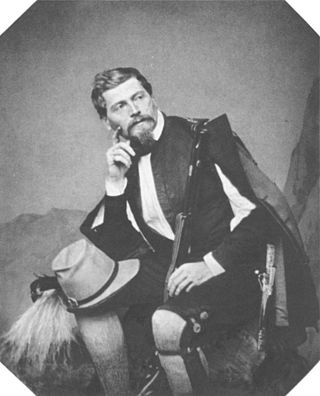
Ludwig Samson Heinrich Arthur Freiherr von und zu der Tann-Rathsamhausen was a Bavarian general.

Duke Maximilian Joseph in Bavaria, known informally as Max in Bayern, was a member of a junior branch of the royal House of Wittelsbach who were Kings of Bavaria, and a promoter of Bavarian folk-music. He is most famous today as the father of Empress Elisabeth of Austria ("Sisi") and great-grandfather of King Leopold III of Belgium.
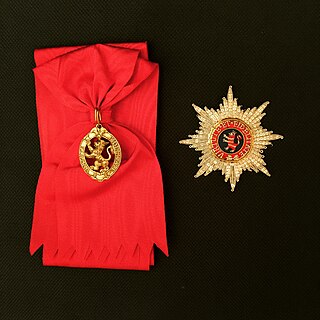
The House Order of the Golden Lion was an order of the German Landgraviate and Electorate of Hesse-Kassel and later, the Grand Duchy of Hesse and by Rhine. It was first instituted in 1770 by Landgrave Frederick II, in honour of and under the patronage of Saint Elizabeth of Hungary, an ancestor of the House of Hesse, and was intended to award auspicious merit.

Adolf Maximilian Ferdinand Gritzner was a German expert on heraldry and a herald in the Ministry of the Interior in Berlin. His reference book on orders of knighthood was still in print in 2000. Gritzner was born in Sorau (Żary) and died in Berlin.

The Wilhelm Order ("Wilhelmsorden") of Hesse-Kassel was instituted by the Elector Friedrich Wilhelm I on 20 August 1851 as a civil and military Order of Merit. It was composed of the three lower grades of the Order of the Golden Lion and a Grand Cross was added. In total the order was awarded more than 450 times in the 16 years of its existence.

The Ludwig Order, was an order of the Grand Duchy of Hesse which was awarded to meritorious soldiers and civilians from 1807 to 1918.
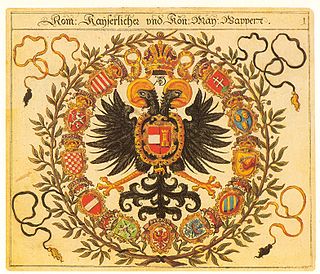
Siebmachers Wappenbuch is a roll of arms first published in 1605 as two heraldic multivolume book series of armorial bearings or coats of arms of the nobility of the Holy Roman Empire, as well as coats of arms of city-states and some burgher families. Founded and compiled by Johann Ambrosius Siebmacher, a German heraldic artist, copperplate engraver, etcher and publisher from Nuremberg, these works became an important source of heraldry of the German-speaking regions.

The Friedrich Order was an order of merit of the German Kingdom of Württemberg. It was instituted on 1 January 1830 by the second king of Württemberg, Wilhelm I in remembrance of his father, King Friedrich I. In 1918, the end of the monarchy meant the abolition of the order.
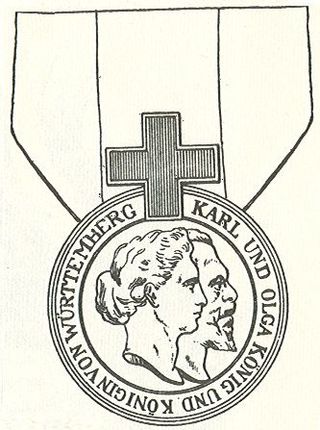
The Order of Olga (Württemberg) was created by Karl I, King of Württemberg, on 27 June 1871, to honor his queen consort, Grand Duchess Olga Nikolaevna of Russia. Its primary purpose was to honor women who cared for wounded soldiers in the Franco-Prussian War of 1870 – 1871. While it was conferred on a few men, it remained largely a women's order.
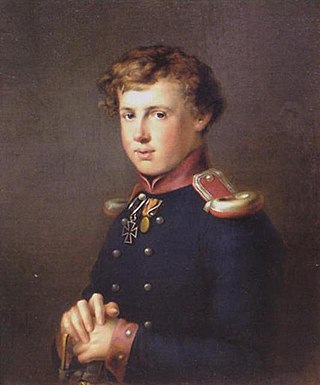
George Bernhard of Anhalt-Dessau, was a German prince of the House of Ascania from the Anhalt-Dessau branch.
Arnold Christian Maria Joseph Rüdiger Freiherr von Biegeleben was a German general during World War II who commanded the 6th Infantry Division of the Wehrmacht. He was awarded the Knight's Cross of the Iron Cross.

Count John V of Nassau-Siegen, German: Johann V. Graf von Nassau-Siegen, official titles: Graf zu Nassau, Vianden und Diez, Herr zu Breda, was since 1475 Count of Nassau-Siegen and of half Diez. He descended from the Ottonian Line of the House of Nassau.

The Cross of Merit for Women and Girls was created on 22 March 1871 by Kaiser Wilhelm I, German Emperor, in his capacity as King of Prussia. The award was presented only to women, but was not a Ladies Order in the most narrow sense. Women and girls were awarded at the request of Empress Augusta, and the award was bestowed by the Kaiser.
The Ordre de la Sincérité, was an order of knighthood of the German Margrave of Bayreuth. The order's name came from 18th-century courtiers who spoke French. The order had fifty knights. It was later renamed the Order of the Brandenburg Red Eagle and later as the Order of the Red Eagle.

The Pour la vertu militaire was a military order of merit established on 25 February 1769 by Frederick II, Landgrave of Hesse-Kassel. The order, modelled on the Prussian Pour le Mérite, could be awarded in a single class to officers of Hessian army or allied armies for wartime or peacetime military merit. When awarded for peacetime merit, only officers from major upwards were eligible. In 1820 the French name was changed to German: Militär-Verdienstorden. It was discontinued in 1866, after the annexation of Hessen-Kassel by the Kingdom of Prussia.
Erich Gritzner was a German heraldist, genealogist and sigillographer, known for his research of German nobility. He was the son of heraldist Maximilian Gritzner (1843–1902).
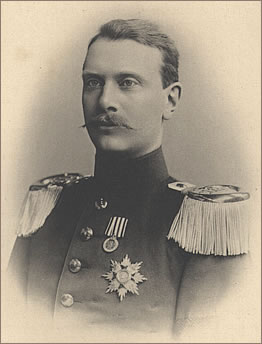
The House Order of Fidelity is a dynastic order of the Margraviate of Baden. It was established by Charles III William, Margrave of Baden-Durlach as a reward for merit and to mark the laying of the foundation stone of his residence at Karlsruhe Palace. As was customary at that time, it was originally named in French as the Ordre de la Fidélité, before later being renamed the Orden der Treue and finally in 1840 the Hausorden der Treue. Its motto was Fidelitas, which is also part of Karlsruhe, Germany's coat of arms.

Gustav Friedrich Beyer was a Prussian general and war minister of the Grand Duchy of Baden.



















